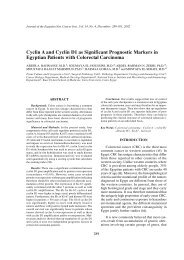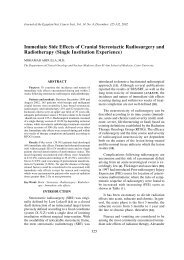Limb Sparing Surgical Resection of Groin Sarcoma. Surgical ... - NCI
Limb Sparing Surgical Resection of Groin Sarcoma. Surgical ... - NCI
Limb Sparing Surgical Resection of Groin Sarcoma. Surgical ... - NCI
You also want an ePaper? Increase the reach of your titles
YUMPU automatically turns print PDFs into web optimized ePapers that Google loves.
282A high percentage <strong>of</strong> patients having groinsarcoma presents to <strong>NCI</strong> Cairo University withsome sort <strong>of</strong> improper management in the form<strong>of</strong> improper long transverse incision for biopsyor trial <strong>of</strong> resection, incomplete excision withgross residual disease left, usually near thepubic bone, around femoral vessels or a missedintrapelvic component. Some cases may havea recurrent disease after previous surgery withor without radiotherapy and need salvage surgery.Patients may be referred for primary radiotherapyby inexperienced surgeons in nonspecialized centers [5].The aim <strong>of</strong> this study is to evaluate thefeasibility <strong>of</strong> limb sparing surgical resectionand reconstructive options in 14 patients havinggroin s<strong>of</strong>t tissue sarcoma; most <strong>of</strong> them weresubjected to improper management before presentationto <strong>NCI</strong>, Cairo University. Oncologicoutcome and functional results <strong>of</strong> those patientsare also reported.MATERIAL AND METHODSThis study was conducted in the NationalCancer Institute, Cairo University during theperiod from January 2001 to December 2006and included 14 patients having s<strong>of</strong>t tissuesarcoma <strong>of</strong> the groin.Preoperative clinical evaluation included amedical history <strong>of</strong> previous surgery or radiotherapyand a physical examination with assessment<strong>of</strong> distal pulsation <strong>of</strong> the popliteal andtibial vessels and femoral nerve function. Presenceor absence <strong>of</strong> distal edema was determinedby visual inspection and by determining indentation<strong>of</strong> the pretibial skin. The presence <strong>of</strong>edema warrants preoperative Doppler ultrasonographyto assess patency <strong>of</strong> the ile<strong>of</strong>emoralvein. Preoperative edema was seen in two casesand duplex showed no thrombosis <strong>of</strong> femoralvein.Preoperative staging studies included plainradiograph to the pelvic bone, CT and MRI withcontrast to assess local extension <strong>of</strong> the tumorespecially intrapelvic extension, the relation <strong>of</strong>the tumor to the ile<strong>of</strong>emoral vessels whetherdisplaced or surrounded by the tumor. Duplexassesses the patency <strong>of</strong> the lumen <strong>of</strong> vessels.MRA and conventional or CT angiography weredone to assess vascular involvement. Chest CTscan was done routinely to all patients to exclude<strong>Limb</strong> <strong>Sparing</strong> <strong>Surgical</strong> <strong>Resection</strong> <strong>of</strong> <strong>Groin</strong> <strong>Sarcoma</strong>pulmonary metastasis. Vascular involvementwas diagnosed when MRI or CT imaging didnot show a rim <strong>of</strong> normal tissue in the tumorto-vessel interface (Figs. 1-4).One patient had extensive pulmonary metastasesand was excluded from the study. Anotherpatient had single pulmonary nodule andwas included in the study. He was subjected tolimb sparing surgery and metastatectomy. Radiologicalvascular involvement was seen in 2cases who were subjected to salvage procedure.One patient had extensive recurrent diseasewith extensive involvement <strong>of</strong> the bony pelvisand ili<strong>of</strong>emoral vessels that necessitate externalhemipelvectomy and was subjected to externalhemipelvectomy and excluded from the study.Finally the salvage procedure was done in 14cases.According to the Enneking staging system[6], 9 patients had stage II, 4 had stage IIA andone patient had stage III. Six cases had variabledegrees <strong>of</strong> intraapelvic extension through theobturator foramen.Histopathological study was done throughrevision <strong>of</strong> previous pathology reports for caseswhich received any type <strong>of</strong> surgery or biopsybefore referral to us (no. 11 cases). Tru-cutneedle, or core biopsy was done for new cases(4 cases). The histological types encounteredwere synovial sarcoma (2 cases), malignantfibrohistiocytoma (4 cases), fibrosarcoma (6cases), hemangiopericytoma (1 case) and liposarcoma(1 case).The extent <strong>of</strong> surgical technique, complicationsand functional results <strong>of</strong> limb-salvagesurgery compared with amputation were discussedwith the patients and consent for operationwas signed in.Tumor resection:Primary tumors without skin involvementand with minimal intrapelvic extension wereapproached through a modified radical groinincision [4]. If groin sarcoma has large extensioninto the pelvis it was preferred to be approachedthrough abdominoinguinal incision that allowsintraabdominal exploration with better exposure<strong>of</strong> pelvic structures [7]. In patients who havesome sort <strong>of</strong> previous management or recurrentcases, the incision was modified accordinglyto include the previous scar or the skin over the
















